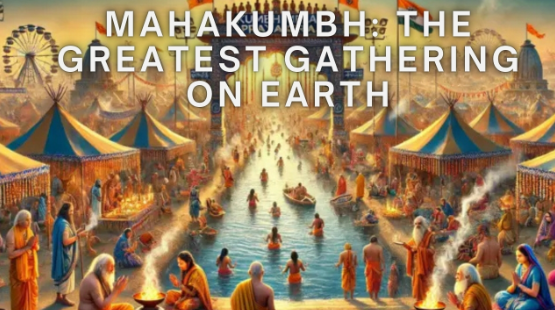The Mahakumbh, often referred to as the greatest gathering on Earth, is a grand spectacle of faith, culture, and humanity. Held every one hundred forty-four years, it draws millions of devotees, spiritual seekers, and curious travelers from across the globe. Rooted deeply in the spiritual and cultural ethos of India, this festival transcends religious boundaries and stands as a testament to the enduring power of belief and tradition.
The Origins of Mahakumbh
The origins of the Mahakumbh trace back to ancient Hindu mythology. According to the Puranas, the gods and demons once joined forces to churn the ocean of milk (“Samudra Manthan”) to obtain the nectar of immortality (“Amrita”). When the pot of nectar emerged, a fierce struggle ensued, lasting 12 divine days, equivalent to 12 human years. During this tussle, drops of nectar fell at four sacred sites: Prayagraj (Allahabad), Haridwar, Ujjain, and Nashik. These locations are now the venues for the Kumbh Mela, with the Mahakumbh taking place in Prayagraj, the confluence of the Ganga, Yamuna, and the mythical Saraswati rivers.
The Spiritual Significance
The Mahakumbh is more than just a festival; it is a profound spiritual experience. Devotees believe that bathing in the holy waters during the auspicious period cleanses them of sins and liberates them from the cycle of birth and rebirth (“Moksha”). The confluence, or “Sangam,” of the three rivers at Prayagraj holds immense significance, symbolizing the union of physical, spiritual, and cosmic realms.
Sadhus, saints, and spiritual leaders from diverse traditions converge at the Mahakumbh to guide and inspire the masses. The festival becomes a melting pot of philosophies, rituals, and discourses, fostering a sense of unity amidst diversity.
The Scale and Organization
The Mahakumbh is unparalleled in scale, often attracting over 100 million people over its two-month duration. Managing such a massive gathering requires meticulous planning and coordination. Temporary infrastructure resembling a small city is erected, complete with tents, roads, sanitation facilities, healthcare centers, and security arrangements.
Advanced technologies, including GPS systems, drones, and AI-driven crowd management tools, are employed to ensure the smooth conduct of the festival. Volunteers, government agencies, and non-profit organizations work tirelessly to provide services and assist pilgrims.
Rituals and Activities
The Mahakumbh’s main attraction is the “Shahi Snan” or royal bath, when ascetics and saints of various sects take a dip in the holy waters in a grand procession. These processions are vibrant, with chants, music, and the display of traditional banners and symbols. The Nagas, or naked ascetics, often draw significant attention with their austere lifestyle and striking presence.
Apart from bathing rituals, the Mahakumbh features spiritual discourses, devotional singing (“Bhajans”), and cultural performances. Visitors also explore the “Akharas,” or monastic organizations, which play a central role in the festival. These Akharas represent different Hindu sects and are hubs of religious and philosophical learning.
Cultural and Economic Impact
The Mahakumbh is not just a religious event; it is a cultural phenomenon. It showcases the rich tapestry of India’s heritage, including traditional music, dance, art, and cuisine. Folk artists and craftsmen find a platform to display their talents, adding vibrancy to the festival.
Economically, the Mahakumbh generates significant revenue. From small vendors selling religious items to large-scale tourism enterprises, countless livelihoods are linked to the event. Hotels, transportation services, and local businesses witness a surge in demand, contributing to regional development.
Environmental Concerns and Initiatives
Hosting a gathering of this magnitude poses environmental challenges, particularly concerning waste management and water pollution. Authorities have increasingly emphasized eco-friendly practices to minimize the festival’s ecological footprint. Initiatives such as the use of biodegradable materials, waste segregation, and clean-up drives are actively promoted.
Efforts are also made to preserve the sanctity of the rivers. Projects like “Namami Gange” aim to rejuvenate the Ganga and ensure that the holy waters remain pristine for future generations.
Global Appeal
The Mahakumbh’s allure extends far beyond India’s borders. Tourists and researchers from around the world attend the festival to witness its grandeur and delve into its spiritual significance. International media coverage and documentaries have further amplified its global reputation, making it a symbol of India’s spiritual and cultural legacy.
Challenges and Resilience
Despite its grandeur, the Mahakumbh faces challenges. Managing the safety and well-being of millions in a confined area is no small feat. Past events have witnessed incidents like stampedes, highlighting the need for robust crowd management.
However, the resilience of the organizers and the faith of the pilgrims ensure that the festival continues to thrive. Continuous improvements in infrastructure, technology, and planning have enhanced the experience for participants while addressing safety concerns.
Personal Stories and Transformations
The Mahakumbh is not just about rituals; it is about personal journeys and transformations. For many, it is a once-in-a-lifetime opportunity to connect with their spiritual roots. Stories of individuals finding solace, clarity, and purpose amidst the chaos are a testament to the festival’s transformative power.
Visitors often describe the Mahakumbh as an overwhelming yet enriching experience. The sight of millions united in faith, the aroma of incense, the sounds of devotional chants, and the touch of the sacred waters leave an indelible impression on the heart and soul.
Conclusion
The Mahakumbh stands as a beacon of spirituality, unity, and cultural richness. It is a celebration of humanity’s eternal quest for meaning and connection. As the greatest gathering on Earth, it transcends boundaries, bringing together people from all walks of life in a shared celebration of faith and tradition.
In an ever-changing world, the Mahakumbh remains a timeless reminder of the enduring power of belief and the unifying force of culture. It is not just a festival; it is a living testament to the beauty and resilience of the human spirit.



More Stories
Savoring Traditions on Georgia’s National Day
Reasons to Visit Dubai Parks and Resorts
Top Events for Uzbekistan National Day